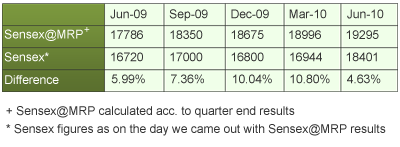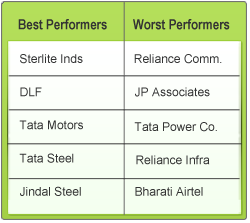
As investors, we are used to seeing the Sensex fluctuate every minute. And to make investing more profitable and not a game of mere chance we need a solution. A solution which could help us ascertain whether the market is over-reacting or under-reacting, whether it is grossly depressed or irrationally exuberant. This is exactly what Sensex@MRP is!
Sensex@MRP is our endeavour to make sense of the benchmark index Sensex. Considering that the Sensex stocks are the top traded stocks of the country, we can expect them to be traded at their MRPs. Thus, Sensex@MRP gives an indication of whether the Sensex is fairly valued or whether irrationality is driving the markets. Most of you must have gone through our earlier reports about Sensex@MRP which explained to you how the concept works and can help individual investors. We have been calculating Sensex@MRP for the last 5 quarters since June 2009 quarter. So, with the June 2010 quarter results out for the Sensex companies, where does the Sensex@MRP stand?
 The free float market capitalization at the MRP of the individual stocks as computed by us at MoneyWorks4me.com and using share data as on 20th August 2010 is Rs. 1,506,251.18 Cr. Using the index divisor 78.06 (as on 20th August 2010) the Sensex@MRP comes out to 19,295.
The free float market capitalization at the MRP of the individual stocks as computed by us at MoneyWorks4me.com and using share data as on 20th August 2010 is Rs. 1,506,251.18 Cr. Using the index divisor 78.06 (as on 20th August 2010) the Sensex@MRP comes out to 19,295.
The Sensex@MRP considering the June 2010 quarter thus puts us in an interesting situation. Considering the value of Sensex as on 20th August viz. 18,401, Sensex is just 890 points or 4.6% away from touching the Sensex@MRP.

Sensex@MRP which is driven primarily by the earnings of the the Sensex companies has increased by just 1.57% to 19,295 for the June 2010 quarter from 18,996 for the March 2010 quarter. This when the Sensex has climbed more than 8% over the same period. This indicates that the rise in the Sensex is not justified by the rise in earnings alone. This is also reaffirmed by the Sensex PE which is close to 22 currently.
Since September 2009, Sensex had been trading in the range of 16000 – 18000 however in July it managed to cross the psychological barrier of 18,000. This movement has been due to the sustained buying by foreign institutional investors over the last few months. Infact, in this calendar year, FIIs have been net buyers of Rs 55,003 crore ($12 billion). The movement of Sensex seems to be driven by the FII inflow who are looking at emerging markets to invest the excess cash rather than the developed markets which still seem to have not recovered completely.
Closer look at earnings
The earnings figures for the Sensex companies infact reveal that the results have been below expectations. For the June 2010 quarter, 15 companies recorded a Y-o-Y growth in earnings whereas the rest 15 recorded a drop even though most people were expecting the growth seen in the previous quarters to continue in the June quarter as well.
 The best performers amongst the Sensex companies were Sterlite Inds, DLF, Tata Motors, Tata Steel and Jindal Steel. Banks like SBI, HDFC bank also managed to record an impressive performance driven by the recovering economy and favourable monetary policy. Sterlite Inds, was the top performer notching 35% in Net Sales and around 200% rise in EPS for June 2010 as compared to June 2009 driven by higher volumes in zinc and copper and better margins. Tata Motors reported an impressive performance backed by the Jaquar-Land Rover business and improved domestic performance.
The best performers amongst the Sensex companies were Sterlite Inds, DLF, Tata Motors, Tata Steel and Jindal Steel. Banks like SBI, HDFC bank also managed to record an impressive performance driven by the recovering economy and favourable monetary policy. Sterlite Inds, was the top performer notching 35% in Net Sales and around 200% rise in EPS for June 2010 as compared to June 2009 driven by higher volumes in zinc and copper and better margins. Tata Motors reported an impressive performance backed by the Jaquar-Land Rover business and improved domestic performance.
The companies which recorded the worst performance were led, quite predictably, by Telecom majors, Reliance Communications and Bharti Airtel. The Infrastructure sector also continued its woes with majors like JP Associates and Reliance Infra recording a disappointing performance.
So, what should we as investors do?
At the current levels of 18,400, Sensex is just 4.63% below the Sensex@MRP. This is the closest the Sensex has been to the Sensex@MRP over the last five quarters. Currently 14 companies out of the Sensex 30 companies are quoting above their MRP. The rest are quoting below the MRP, however the margin of safety is not much. If the FIIs continue to pump money in the Indian stock markets, the Sensex may move further up and cross Sensex@MRP. This means that quite a few stocks will be quoting considerably above their MRP. The problem here is that going forward, earnings for the Sensex companies are not expected to be spectacular in the next few quarters. Infact because of the higher base seen last year, the growth may be lower which could lead to a correction.
As history has shown us, there is a very high chance of a correction happening once the Sensex crosses Sensex@MRP, especially if the rise is not backed by earnings growth. The best thing to do now would be to keep a close watch on your investments and if they are above their MRP, be on the look out for selling signals. As individual investors right now the most important thing to remember is:
“Stay on your Guard to book profits!”
If you liked what you read and would like to put it in to practice Register at MoneyWorks4me.com. You will get amazing FREE features that will enable you to invest in Stocks and Mutual Funds the right way.
 |
The Sensex@MRP considering the June 2010 quarter thus puts us in an interesting situation. Considering the value of Sensex as on 20th August viz. 18,401, Sensex is just 890 points or 4.6% away from touching the Sensex@MRP.
Need help on Investing? And more….Puchho Befikar
Kyunki yeh paise ka mamala hai
Start Chat | Request a Callback | Call 020 6725 8333 | WhatsApp 8055769463







The MRP of a stock depends primarily on the earnings capacity of the company. You can read more on how you can calculate it in our post on MRP. Please click on the link given below.
http://bit.ly/b24Pv9
Do let us know in case you have any other queries and also remember to post your feedback!
Thanks!